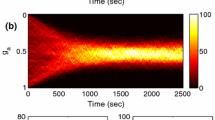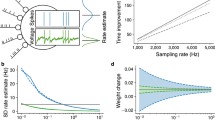Abstract
We present two weight- and spike-time dependent synaptic plasticity rules consistent with the physiological data of Bi and Poo (J Neurosci 18:10464–10472, 1998). One rule assumes synaptic saturation, while the other is scale free. We extend previous analyses of the asymptotic consequences of weight-dependent STDP to the case of strongly correlated pre- and post-synaptic spiking, more closely resembling associative learning. We further provide a general formula for the contribution of any number of spikes to synaptic drift. Asymptotic weights are shown to principally depend on the correlation and rate of pre- and post-synaptic activity, decreasing with increasing rate under correlated activity, and increasing with rate under uncorrelated activity. Spike train statistics reveal a quantitative effect only in the pre-asymptotic regime, and we provide a new interpretation of the relation between BCM and STDP data.
Similar content being viewed by others
References
Abbott LF, Nelson SB (2000) Synaptic plasticity: taming the beast. Nat Neurosci 3:1178–1183
Bair W, Koch C, Newsome W, Britten K (1994) power spectrum analysis of bursting cells in area mt in the behaving monkey. J Neurosci 14(5):2870–2892
Bi GQ (2002) Spatiotemporal specificity of synaptic plasticity: cellular rules and mechanisms. Biol Cybern 87:319–332
Bi GQ, Poo MM (1998) Synaptic modifications in cultured hippocampal neurons: dependence on spike timing, synaptic strength, and postsynaptic cell type. J Neurosci 18:10464–10472
Bienenstock EL, Cooper LN, Munro PW (1982) Theory for the development of neuron selectivity: orientation specificity and binocular interaction in visual cortex. J Neurosci 2(1):32–48
Bliss TVP, Lømo TJ (1973) Long-lasting potentiation of synaptic transmission in the dentate area of the anaesthetized rabbit following stimulation of the perforant path. J Physiol 232:331–356
Burkitt A, Meffin H, Grayden DB (2004) Spike-timing-dependent plasticity: the relationship to rate-based learning for models with weight dynamics determined by a stable fixed point. Neural Comput 16:885–940
Debanne D, Gahwiler BH, Thompson SM (1996) Cooperative interactions in the induction of long-term potentiation and depression of synaptic excitation between hippocampal ca3-ca1 cell pairs in vitro. Proc Natl Acad Sci USA 93:11225–11230
Debanne D, Gahwiler BH, Thompson SM (1999) Heterogeneity of synaptic plasticity at unitary ca3-ca1 and ca3-ca3 connections in rat hippocampal slice cultures. J Neurosci 19(24):10664–10671
Dudek SM, Bear MF (1992) Homosynaptic long-term depression in area ca1 of hippocampus and effects of n-methyl-d-aspartate receptor blockade. Proc Natl Acad Sci USA 89:4363–4367
Froemke RC, Dan Y (2002) Spike-timing-dependent synaptic modification induced by natural spike trains. Nature 416(6879):433–438
Froemke RC, Tsay IA, Raad M, Long JD, Dan Y (2006) Contribution of individual spikes in burst-induced long-term synaptic dification. J Neurophysiol 95:1620–1629
Gütig R, Aharonov R, Rotter S, Sompolinsky H (2003) Learning input correlations through nonlinear temporally asymmetric hebbian plasticity. J Neurosci 23:3697–3714
Hasselmo ME (1995) Neuromodulation and cortical function: modeling the physiological basis of behavior. Behav Brain Res 67:1–27
Hebb DO (1949) The organisation of behaviour. Wiley, New York
Izhikevich EM, Desai NS (2003) Relating stdp to bcm. Neural Comput 15(7):1511–1523
Kempter R, Gerstner W, van Hemmen JL (1999) Hebbian learning and spiking neurons. Phys Rev E 59(4):4498–4514
Kirkwood A, Rioult MG, Bear MF (1996) Experience-dependent modification of synaptic plasticity in visual cortex. Nature 381:526–528
Kistler WM, van Hemmen JL (2000) Modeling synaptic plasticity in conjunction with the timing of pre- and post-synaptic action potentials. Neural Comput 12:385–405
Kuhn A, Aertsen A, Rotter S (2003) Higher-order statistics of input ensembles and the response of simple model neurons. Neural Comput 15:67–101
Levy WB, Steward O (1983) Temporal contiguity requirements for long-term associative potentiation/depression in the hippocampus. Neuroscience 8:791–797
Lynch G, Dunwiddie T, Gribkoff V (1977) Heterosynaptic depression: a postsynaptic correlate of long-term potentiation. Nature 266:737–739
Markram H, Löbke J, Frotscher M, Sakmann B (1997) Regulation of synaptic efficacy by coincidence of postsynaptic aps and epsps. Science 275(5297):213–215
Montgomery JM, Pavlidis P, Madison DV (2001) Pair recordings reveal all-silent synaptic connections and the postsynaptic expression of long-term potentiation. Neuron 29:691–701
O’Connor DH, Wittenberg GM, Wang SSH (2005a) Dissection of bidirectional synaptic plasticity into saturable unidirectional processes. J Neurophysiol 94:1565–1573
O’Connor DH, Wittenberg GM, Wang SSH (2005b) Graded bidirectional synaptic plasticity is composed of switch-like unitary events. Proc Natl Acad Sci USA 102(27):9679–9684
Petersen CC, Malenka RC, Nicoll RA, Hopfield JJ (1998) All-or-none potentiation at ca3-ca1 synapses. Proc Natl Acad Sci USA 95:4732–4737
van Rossum MCW, Bi GQ, Turrigiano GG (2000) Stable hebbian learning from spike timing-dependent plasticity. J Neurosci 20(23):8812–8821
Rubin J, Lee DD, Sompolinsky H (2001) Equilibrium properties of temporally asymmetric hebbian plasticity. Phys Rev Lett 86:364
Shah NT, Yeung LC, Cooper LN, Cai Y, Shouval HZ (2006) A biophysical basis for the inter-spike interaction of spike-timing-dependent plasticity. Biol Cybern 95:113–121
Sjöström PJ, Turrigiano GG, Nelson SB (2001) Rate, timing, and cooperativity jointly determine cortical synaptic plasticity. Neuron 32:1149–1164
Song S, Miller KD, Abbott LF (2000) Competitive hebbian learning through spike-timing-dependent synaptic plasticity. Nat Neurosci 3(9):919–926
Wang HX, Gerkin RC, Nauen DW, Bi GQ (2005) Coactivation and timing-dependent integration of synaptic potentiation and depression. Nat Neurosci 8(2):187–193
Author information
Authors and Affiliations
Corresponding author
Rights and permissions
About this article
Cite this article
Standage, D., Jalil, S. & Trappenberg, T. Computational consequences of experimentally derived spike-time and weight dependent plasticity rules. Biol Cybern 96, 615–623 (2007). https://doi.org/10.1007/s00422-007-0152-6
Received:
Accepted:
Published:
Issue Date:
DOI: https://doi.org/10.1007/s00422-007-0152-6




